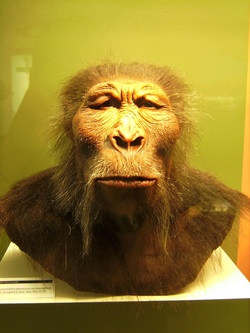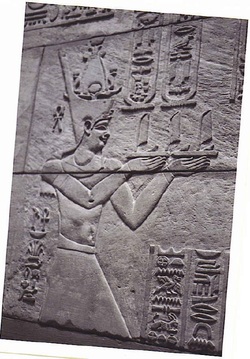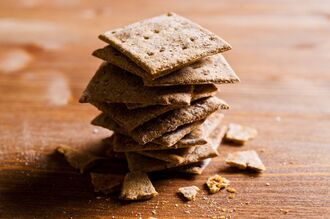The Snacks of Early Humans

Paranthropus Model
We’ve come a long ways in snacking technology since our early ancestors, but many are surprised that snacking played a vital role in the lives of our early ancestors. In fact, some scientists believe that early human snacking was what differentiated humans from similar bipedal (walk on two legs) hominids.
Let me explain—a species similar to humans known as paranthropus lived at the same time as early humans. This species is believed to have had a very strict diet, so after a particularly dry spell in Africa, the plants this creature normally ate died away. As soon as the plants disappeared, so did Paranthropus (1).
While the Paranthropus was looking for a particular type of plant to eat, modern humans were able to adapt. We ate nuts, meat, a variety of plants, and whatever else we could shove in our pie holes (1).
A recent paper in The Journal of Human Evolution found that early humans diets varied even more than we could imagine. The paper found that 12,000 years ago humans regularly snacked on other humans (I wonder if early humans had "fava beans and a nice chianti") . These scientists found human gnaw marks on ancient bones(2).
I’m pretty sure, even back then, I wouldn’t back that snack.
Let me explain—a species similar to humans known as paranthropus lived at the same time as early humans. This species is believed to have had a very strict diet, so after a particularly dry spell in Africa, the plants this creature normally ate died away. As soon as the plants disappeared, so did Paranthropus (1).
While the Paranthropus was looking for a particular type of plant to eat, modern humans were able to adapt. We ate nuts, meat, a variety of plants, and whatever else we could shove in our pie holes (1).
A recent paper in The Journal of Human Evolution found that early humans diets varied even more than we could imagine. The paper found that 12,000 years ago humans regularly snacked on other humans (I wonder if early humans had "fava beans and a nice chianti") . These scientists found human gnaw marks on ancient bones(2).
I’m pretty sure, even back then, I wouldn’t back that snack.
Snacks of the First Civilizations

Egyptians
The Egyptian Royalty frequently snacked on figs, dates, bread and honey. Along with these snacks the Egyptians drank a beer brewed from barley. The Egyptians were able to snack heartily because they lived on fairly fertile land.(3)
We know what type of snacks Egyptians ate because they were often buried with a bunch of snacks that they could eat on their way to the afterlife. There were also depictions of food painted on the walls of Egyptian tombs.(4)
Ancient Chinese
“Dim Sum” is a term that the ancient Chinese used to describe small portions of food. This term was not used, as it is today, where you could have dim sum as a meal. Dim sum was simply meant as a snack. The term literary translates into “touches the heart.” (5)
Dim sum could include buns, rice, noodles, beef, chicken, or soup. Most of the time these snacks were served with tea.
Aztecs
The Aztecs brought an amazing revolution to snacking—CHOCOLATE!
The first chocolate that the Aztecs invented was not a sweet chuck of melt in your mouth sweetness, instead it was a frothy beer like drink that noblemen and warriors drank on special occasions. (6)
The Egyptian Royalty frequently snacked on figs, dates, bread and honey. Along with these snacks the Egyptians drank a beer brewed from barley. The Egyptians were able to snack heartily because they lived on fairly fertile land.(3)
We know what type of snacks Egyptians ate because they were often buried with a bunch of snacks that they could eat on their way to the afterlife. There were also depictions of food painted on the walls of Egyptian tombs.(4)
Ancient Chinese
“Dim Sum” is a term that the ancient Chinese used to describe small portions of food. This term was not used, as it is today, where you could have dim sum as a meal. Dim sum was simply meant as a snack. The term literary translates into “touches the heart.” (5)
Dim sum could include buns, rice, noodles, beef, chicken, or soup. Most of the time these snacks were served with tea.
Aztecs
The Aztecs brought an amazing revolution to snacking—CHOCOLATE!
The first chocolate that the Aztecs invented was not a sweet chuck of melt in your mouth sweetness, instead it was a frothy beer like drink that noblemen and warriors drank on special occasions. (6)
Snacks of the Iron Age
|
In the Iron Age, life was tough. People had to hunt for food, gather berries, and forage for nuts and seeds. But when hunger struck, what did they turn to for a quick snack? Let me tell you, it wasn't exactly a smorgasbord of options.
First of all, forget about chocolate bars, chips, and ice cream. The closest thing they had to a sweet treat was honey. Imagine carrying around a jar of sticky, gooey honey in your pocket all day, hoping it doesn't leak or attract bugs. And if you didn't have access to honey, your options were limited to fruit, like apples or figs. Not quite the same as a candy bar, is it? Now, let's talk about savory snacks. The favorite snack of the Iron Age was probably a hunk of bread. Yes, that's right, bread. But not just any bread - hardtack. Hardtack is a cracker-like bread that's made by mixing flour, water, and salt, and baking it until it's tough as nails. It was durable and could be stored for months, but it was also so hard that you had to soak it in water or soup before eating it. Can you imagine nibbling on a rock-hard cracker and hoping it doesn't break your teeth? No wonder cavemen had such strong jaws. If you were lucky, you might come across some cured meat or cheese. But let's be real, that was a rare luxury. Most people had to settle for small game, like rabbits or squirrels, or whatever they could scavenge from their surroundings. And if you were really desperate, you could always resort to insects. Yes, insects. Beetles, ants, and grasshoppers were a good source of protein and could be roasted until crispy. Yum. All in all, snacks in the Iron Age were pretty bleak. No wonder people died so young - they probably just gave up on life after years of chewing on hardtack and roasted beetles. But hey, at least they didn't have to worry about obesity. In fact, I wouldn't be surprised if the word "snack" didn't even exist back then. So next time you're munching on some chips or candy, just remember - you're living in the lap of luxury compared to our Iron Age ancestors. Enjoy it while it lasts. |
1. Cerling et. al. Diet of Paranthropus boisei in the early Pleistocene of East Africa; PNAS 2011; published ahead of print May 2, 2011.
2. Fernández-Jalvoa, Cáceresd, Rosell. Journal of Human Evolution, Volume 37, Issues 3–4. September 1999. Pages 591–622
3. http://www.ehow.com/info_8539732_ancient-egyptian-snacks-kids.html#ixzz29fvzpV31
4. http://www.crystalinks.com/egyptafterlife.html
5. http://chinesefood.about.com/od/diningout/p/dim_sum.htm
6. http://www.dailymail.co.uk/news/article-493335/Chocolate-invented-3-100-years-ago-Aztecs--trying-make-beer.html
2. Fernández-Jalvoa, Cáceresd, Rosell. Journal of Human Evolution, Volume 37, Issues 3–4. September 1999. Pages 591–622
3. http://www.ehow.com/info_8539732_ancient-egyptian-snacks-kids.html#ixzz29fvzpV31
4. http://www.crystalinks.com/egyptafterlife.html
5. http://chinesefood.about.com/od/diningout/p/dim_sum.htm
6. http://www.dailymail.co.uk/news/article-493335/Chocolate-invented-3-100-years-ago-Aztecs--trying-make-beer.html

